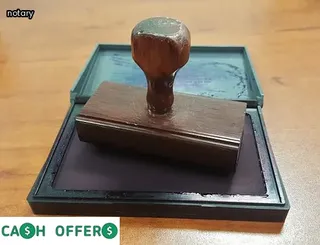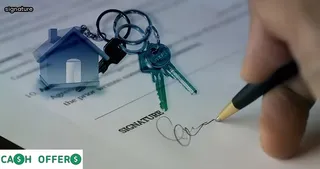Deeds and mortgages are two of the most common documents used when transferring ownership of real estate. A deed is a legal document that transfers ownership from one person to another and is recorded in the local county office.
A mortgage is a loan secured by real estate that gives the lender an interest in the property until it is paid off. Deeds and mortgages may both be used to transfer ownership of property, but they serve different purposes.
When completing a quit claim deed for real estate in Connecticut, you must make sure that all parties involved in the transaction are identified accurately and completely, as well as the full legal description of the property being transferred. All signatures must also be notarized to ensure authenticity.
The deed must then be submitted to the local county office where it will be recorded and become legally binding.

A quit claim deed is a legal document that transfers the title of real estate from one person to another. It is commonly used when a family member needs to transfer property, such as when an estate is being settled or when a home is sold between family members.
In Connecticut, there are specific steps that must be taken in order to successfully complete a quit claim deed. First, the grantor (the individual transferring the property) must provide certain information, including their name and address, the legal description of the property being transferred, and any restrictions on how it can be used.
The grantee (the individual receiving the property) should also provide their name and address. This information should be included in the quit claim deed form that can be obtained from a lawyer or notary.
Next, both parties will need to sign and date the quit claim deed in front of two witnesses and have it notarized by an authorized public notary. The final step is for both parties to file the completed quit claim deed with their local county recorder’s office in order for recordation of ownership to take effect.
Understanding these steps allows you to complete a quit claim deed properly when transferring real estate in Connecticut.
A quit claim deed is a popular form of real estate transfer used in Connecticut. It is an instrument that transfers title or interest in land from one person to another without warranties of title, meaning the seller does not guarantee that they actually have the right to sell the property.
This type of transaction is typically used to transfer property between family members or close friends as it is a quick and inexpensive process. In order to complete a quit claim deed in Connecticut, both parties must be present and sign the document in front of a Notary Public.
Additionally, each party must fill out information such as names, addresses, legal descriptions of the property being transferred, and other relevant information required by the state. The original document must then be filed with the local town clerk's office for recording.
The entire process can take anywhere from several days to several weeks depending on how quickly the paperwork is processed and recorded.

When it comes to real estate in Connecticut, there are a variety of different types of deeds and mortgages that can be used. One such deed is the Quit Claim Deed, which is used to transfer ownership or interest in property from one person to another.
This type of deed is often used for situations in which a person wants to transfer their ownership rights without any guarantee or warranty of title. In order to complete this deed, the grantor must sign and deliver the document to the grantee and have it witnessed by two people.
The deed must also be recorded with the town clerk in the municipality where the property is located. It should include information about both parties, including their names and addresses, as well as details about the property being transferred, such as its address and legal description.
Once all necessary documents are signed and recorded properly, then a new deed will be created that reflects the change in ownership rights.
Using forms to complete a quit claim deed for real estate in Connecticut can be beneficial in many ways. Forms provide an easy-to-follow structure that guides you through the process and helps to ensure accuracy.
The forms also save time and energy by providing all the necessary information in one place, reducing the need to research or search for specific details. Additionally, since forms are pre-approved, they are usually accepted for filing with the Connecticut Secretary of State’s Office.
If you choose to use forms, you will have peace of mind knowing your documents will meet state requirements. Furthermore, using forms eliminates any potential mistakes due to illegible handwriting or incorrect grammar which could cause delays or rejections when filing with the state.

Finding the right form for your quit claim deed situation in Connecticut can be a challenge. Thankfully, there are many online resources available to help you find the right form for your needs.
The Connecticut Department of Consumer Protection website has an extensive selection of forms related to real estate and other property transfers, including quit claim deeds. Additionally, many local attorneys have experience handling these types of transactions and can provide guidance on which forms should be used in order to ensure a smooth transfer process.
For those who prefer to do their own research, many legal websites offer free information about different types of real estate forms, including how to complete a quit claim deed for real estate in Connecticut. With all these resources, it’s easy to find the information you need to fill out the correct form for your situation.
When writing a legal document such as a quit claim deed, it is important to ensure accuracy and follow the proper procedures. Researching the laws of your state, in this case Connecticut, is essential and can help you understand the requirements for completing a quit claim deed.
Before getting started, consult an attorney to ensure that you are aware of any applicable restrictions or limitations on the property. Additionally, make sure to double-check all information before signing, including names of parties involved in the transaction, address of the property being transferred and any other details included in the document.
When filling out paperwork associated with a quit claim deed, make sure all forms are properly filled out and signed by both parties involved. Lastly, be sure to have all documents notarized and recorded with your county's office so that they can become legally binding documents.

Creating an accurate legal document like a quit claim deed for real estate in Connecticut is important to ensure that the benefits and rights of all parties involved are protected. To do so, one should begin by understanding what a quit claim deed entails and why it's used.
The document must contain certain language as specified by Connecticut law, and must include signatures from both parties – the grantor (person transferring the property) and the grantee (person receiving the property). Information such as the address of the property, along with a detailed description, should also be included.
Additionally, any applicable restrictions or encumbrances should be noted in order to avoid potential issues down the line. After ensuring all necessary information has been entered accurately into the document, have each party sign and date it in front of an appropriate witness.
Finally, file the completed deed with the county clerk’s office for public records purposes. By following these steps when creating a quit claim deed for real estate in Connecticut, you can ensure that your legal document is accurate and properly executed.
When completing a quit claim deed for real estate in Connecticut, it is essential to understand the necessary property location requirements. Generally, this includes details about the exact piece of land being transferred and its location within the state.
This is typically done by providing an address or legal description. The address should include pertinent information such as the street name, city, state and zip code.
The legal description is more specific and consists of elements like the plot number and section/township/range numbers. In addition, if the transfer involves two or more properties in different locations, separate deeds should be completed for each one.
Lastly, it is important to check with local authorities to make sure any zoning regulations are followed when completing a quit claim deed in Connecticut.

Online forms offer the convenience of being able to complete and submit documents from anywhere. However, when it comes to important legal matters such as filing a quit claim deed for real estate in Connecticut, there are some drawbacks to using an online form.
One of the main cons is that you may not be certain whether or not all necessary information is included in the document. Additionally, if you make a mistake on any of the fields, it could cause delays or require additional paperwork to correct.
Furthermore, you may not be able to access assistance with filling out the form if you have questions. Online forms do provide more flexibility than traditional mail-in forms but having a professional review your paperwork can give you peace of mind and help ensure accuracy in completing your quit claim deed for real estate in Connecticut.
Submitting your deed or mortgage online is a great way to quickly and securely complete the process of transferring real estate in Connecticut. To initiate the online process, you must first have a quit claim deed that has been properly notarized and completed.
Once you have these documents, you will need to bring them to the local town office or county courthouse so they can be filed with the appropriate county clerk. The clerk’s office will then provide you with an electronic copy of your quit claim deed, which can be uploaded onto their website.
From there, all that's left is for you to pay any applicable fees and file your deed or mortgage electronically. With this method, you can rest assured that your real estate transfer is done quickly and efficiently without having to stand in long lines at your local courthouse.

Completing a quit claim deed for real estate in Connecticut can be done online, but there are some common questions that people have about the process. First, it is important to understand that you will need to provide an electronic signature in order to submit all of your documents.
Additionally, you may need to submit additional documents such as proof of identity, proof of address, and other information depending on the specific situation. It is also important to note that you should expect a response from the county clerk within a few days after submitting your quit claim deed.
Furthermore, if you encounter any problems or have questions about the process it is best to contact the county clerk for assistance. Lastly, make sure that all of your documents are filed correctly so that your transaction with the county clerk can be finalized and recorded properly.
When completing a quit claim deed for real estate in Connecticut, it is important to review the guidelines for legal documents and contracts. First, ensure that all parties involved have a clear understanding of the document they are signing.
Review any details concerning the property, such as address, taxes, and liens. Make sure that all signatures are present and legally binding.
Additionally, check whether any additional paperwork or forms are necessary to file with the deed. Lastly, confirm that the deed is correctly notarized before submitting it to the county clerk's office for recording.
It is also wise to seek professional legal counsel if there are any uncertainties about how to approach this process.

Signing, editing, and filing digital documents can be a daunting task. By using the proper tools and understanding the process correctly, you can securely complete a quit claim deed for real estate in Connecticut.
Start by obtaining an electronic copy of the quit claim deed with all necessary information filled out. Make sure to double check for accuracy and edit any errors before signing.
Once completed, utilize a secure file sharing service or digital signature platform to share the document with the other parties involved. File the original document and any copies at your local Connecticut county clerk's office for official recording.
Throughout this process, take extra care to ensure that personal data is kept safe as well as all documents are properly signed, edited, and filed correctly.
When evaluating the quality of free forms available online, it is important to assess the source and make sure that the form is up-to-date with current laws. When it comes to completing a quit claim deed for real estate in Connecticut, there are many online resources that provide free forms.
However, these forms may not be prepared correctly and can potentially lead to legal issues down the road. In order to ensure accuracy, it is best to consult an attorney who specializes in property law who can help you understand what information should be included and answer any questions about the document.
Additionally, you should review all documents thoroughly before signing to make sure that all information is correct and that you understand what you are signing. It is also important to remember that this type of deed only transfers ownership rights from one party to another - it does not guarantee title or provide any warranties about the condition of the property.

Storing important documents securely and conveniently is essential for any real estate owner in Connecticut. A quit claim deed is an important document that should be stored safely, as it transfers the title of a property from one person to another.
To ensure your quit claim deed is stored properly, you can use digital storage services or keep physical copies on file. Digital storage services offer a secure way to store your quit claim deed without having to worry about keeping track of physical documents.
These services are typically password protected, encrypted, and backed up regularly so your document will remain safe and accessible whenever you need it. On the other hand, physical copies of the quit claim deed can also be kept in a fireproof safe.
This is an ideal option if you want to store multiple important documents together in one place; however, make sure to check with your local government for any regulations regarding document storage that may apply to your area.
It is important to protect yourself from any fraudulent practices when completing a Quit Claim Deed for real estate in Connecticut. If you are unfamiliar with the process, it is wise to seek out the guidance of an attorney or legal professional that specializes in property law.
Additionally, it is beneficial to review all documents with care and attention before signing them. Make sure you understand what you are signing and that all information included on the deed is accurate.
It is also recommended to thoroughly research the individual or organization that you are engaging with during the transaction. Requesting background information can help provide peace of mind and make sure that your transaction is in good hands.
Be wary of any individuals or organizations who pressure you into signing a deed without providing time for review, as this may be a sign of fraudulent activity.

Submitting legal documents such as quit claim deeds can be a complicated process. But with the use of the right app, it doesn't have to be.
Streamlining the process of submitting documents for real estate in Connecticut is now easier than ever with the Get The App mobile application. You can easily access all the necessary forms and documents required for filing a quit claim deed from your smartphone or tablet.
From start to finish, Get The App provides step-by-step instructions so you know exactly what to do every step of the way. And if you ever find yourself stuck, there are also helpful guides and tutorials available that will guide you through every stage of completing your quit claim deed.
With Get The App's user friendly interface, anyone can quickly and easily submit their legal documents in no time!.
Connecticut real estate can be transferred through a quit claim deed, which is a legal document that transfers ownership of real estate without any warranties or guarantees. Completing this document requires both parties to fill out and sign the form, which should then be filed with the Connecticut town clerk’s office.
Before you begin the process, it is important to understand all of your legal rights and obligations under Connecticut law. forms.
legal has an extensive knowledge base filled with helpful information about mortgages and other forms related to real estate in Connecticut. You can learn more about how to properly complete a quit claim deed through their resources, such as documents and answers from experts who are knowledgeable about real estate laws in the state.
With forms.legal’s help, you can ensure that your transfer of property is done correctly and legally in Connecticut.
Adding a name to a deed in Connecticut is relatively simple, but there are some important steps that need to be taken. The first step is to obtain a Quit Claim Deed form from the town or city clerk's office where the property is located.
It's important to read the form carefully and understand the specific requirements for completing it properly. Once completed, both parties will need to sign the form in front of two witnesses who will also need to sign it.
After signing, it's necessary for the deed to be notarized by an authorized witness such as a Notary Public or Town Clerk. Once all of these steps have been taken, the Quit Claim Deed needs to be filed with the town or city clerk's office where the property is located in order for it to become effective and binding.
Completing this process correctly can ensure that your name has been added correctly and legally to the deed in Connecticut.

If you are looking to remove a name from the deed for real estate in Connecticut, then a quitclaim deed is likely the best route. A quitclaim deed is a legal document that transfers any interest or claim an individual has on a particular piece of property to another person without making any warranties or guarantees about the title.
To complete the quitclaim deed, you'll first need to obtain and fill out the form. You'll then need to gather two witnesses and have them sign off on the document.
When this is completed, you'll need to record the quitclaim deed with your local town clerk's office in order for it to be legally binding. By following these steps, you can easily remove a name from a deed in Connecticut and transfer ownership rights accordingly.
An executor deed in Connecticut, also known as a quit claim deed, is a legal document used to transfer ownership of real estate from one party to another. Unlike other types of deeds that provide warranties against defects or encumbrances on the title, an executor deed does not.
Instead, all it does is transfer the title from one party to another without providing any guarantees about its condition. In order for an executor deed to be valid in Connecticut, it must be recorded at the local town clerk's office with a properly completed and notarized form.
It must also include specific information such as the names of both parties involved in the transaction and the description of the property being transferred. Once properly filed, an executor deed legally conveys ownership rights from one party to another and will remain in effect until it is revoked by either party or superseded by another deed.
A fiduciary deed in Connecticut is a legal document used to transfer property rights from one owner to another. This type of deed is often used when the current owner wants to give or sell real estate to another individual or an organization.
It can also be used as part of a quit claim deed, which is a way for the original owner to relinquish all rights and interests they have in a piece of property. The fiduciary deed must be signed by both parties involved in the transaction, and it must be filed with the appropriate county recorder's office in order for it to become legally binding.
The deed must also list any liens or encumbrances on the property, so that any future owners are aware of these restrictions before taking ownership.
A: To complete a quit claim deed on a house in Connecticut, you must first gather the necessary documents. Then, fill out the quit claim deed form and sign it in front of a notary public. Finally, submit the quit claim deed to the town clerk’s office.